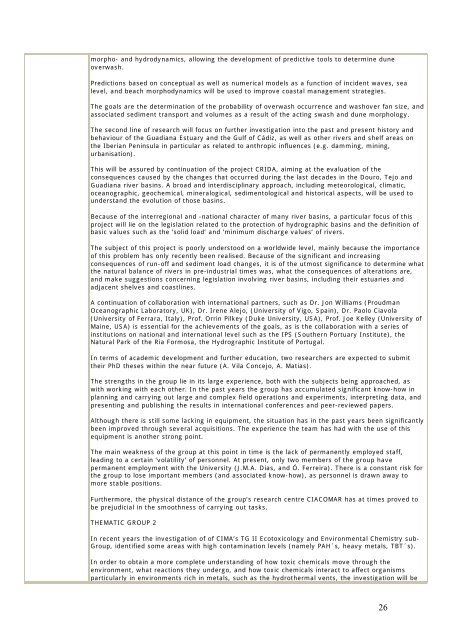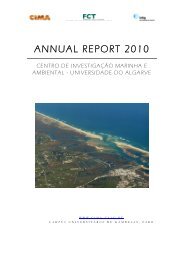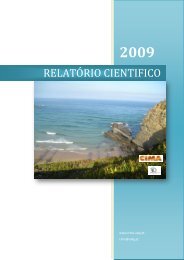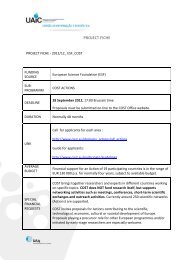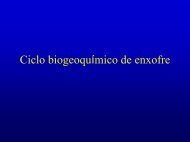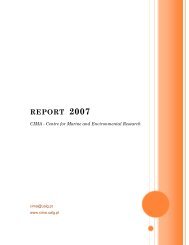morpho- and hydrodynamics, allowing the development of predictive tools to determine duneoverwash.Predictions based on conceptual as well as numerical models as a function of incident waves, sealevel, and beach morphodynamics will be used to improve coastal management strategies.The goals are the determination of the probability of overwash occurrence and washover fan size, andassociated sediment transport and volumes as a result of the acting swash and dune morphology.The second line of research will focus on further investigation into the past and present history andbehaviour of the Guadiana Estuary and the Gulf of Cádiz, as well as other rivers and shelf areas onthe Iberian Peninsula in particular as related to anthropic influences (e.g. damming, mining,urbanisation).This will be assured by continuation of the project CRIDA, aiming at the evaluation of theconsequences caused by the changes that occurred during the last decades in the Douro, Tejo andGuadiana river basins. A broad and interdisciplinary approach, including meteorological, climatic,oceanographic, geochemical, mineralogical, sedimentological and historical aspects, will be used tounderstand the evolution of those basins.Because of the interregional and -national character of many river basins, a particular focus of thisproject will lie on the legislation related to the protection of hydrographic basins and the definition ofbasic values such as the ’solid load’ and ’minimum discharge values’ of rivers.The subject of this project is poorly understood on a worldwide level, mainly because the importanceof this problem has only recently been realised. Because of the significant and increasingconsequences of run-off and sediment load changes, it is of the utmost significance to determine whatthe natural balance of rivers in pre-industrial times was, what the consequences of alterations are,and make suggestions concerning legislation involving river basins, including their estuaries andadjacent shelves and coastlines.A continuation of collaboration with international partners, such as Dr. Jon Williams (ProudmanOceanographic Laboratory, UK), Dr. Irene Alejo, (University of Vigo, Spain), Dr. Paolo Ciavola(University of Ferrara, Italy), Prof. Orrin Pilkey (Duke University, USA), Prof. Joe Kelley (University ofMaine, USA) is essential for the achievements of the goals, as is the collaboration with a series ofinstitutions on national and international level such as the IPS (Southern Portuary Institute), theNatural Park of the Ria Formosa, the Hydrographic Institute of Portugal.In terms of academic development and further education, two researchers are expected to submittheir PhD theses within the near future (A. Vila Concejo, A. Matias).The strengths in the group lie in its large experience, both with the subjects being approached, aswith working with each other. In the past years the group has accumulated significant know-how inplanning and carrying out large and complex field operations and experiments, interpreting data, andpresenting and publishing the results in international conferences and peer-reviewed papers.Although there is still some lacking in equipment, the situation has in the past years been significantlybeen improved through several acquisitions. The experience the team has had with the use of thisequipment is another strong point.The main weakness of the group at this point in time is the lack of permanently employed staff,leading to a certain ‘volatility’ of personnel. At present, only two members of the group havepermanent employment with the University (J.M.A. Dias, and Ó. Ferreira). There is a constant risk forthe group to lose important members (and associated know-how), as personnel is drawn away tomore stable positions.Furthermore, the physical distance of the group’s research centre CIACOMAR has at times proved tobe prejudicial in the smoothness of carrying out tasks.THEMATIC GROUP 2In recent years the investigation of of <strong>CIMA</strong>’s TG II Ecotoxicology and Environmental Chemistry sub-Group, identified some areas with high contamination levels (namely PAH´s, heavy metals, TBT´s).In order to obtain a more complete understanding of how toxic chemicals move through theenvironment, what reactions they undergo, and how toxic chemicals interact to affect organismsparticularly in environments rich in metals, such as the hydrothermal vents, the investigation will be26
focused on metal granules and metallothioneins in benthic organisms.The chemical contaminants from anthropogenic activity (metals, pesticides, hydrocarbons, PAH´s) areable to induce oxidative stress through production of oxyradicals, which increase the activity ofparticular Antioxydant enzymes. So one of the future objectives of this group is the validation of thosebiomarkers linked to the antioxydant enzymes, such as Cu,Zn-SOD using genetic characterisation inthe clams Ruditapes decussatus.Histopathological alterations will be further investigated, since the histological changes represent anintermediate biomarker, more sensitive than growth or reproductive changes, and that allow a betterevaluation of the health of the organisms than a single biochemical parameter. Although the effects ofpollutants on marine organisms are well studied in terms of their toxicity and bioaccumulation, less isknown about their genotoxicity (Pruski & Dixon, 2002). It has been found that pollutants havepotential to cause DNA damage. So another objective of this group is develop research in DNAdamaging potential, as a biomarker of metallic and POP´s contamination.The strategy of the subgroup concerned with the natural variability of marine/coastal systems(Sedimentary Geochemistry & Quaternary Geology) is primarily dictated by the fact that theobservation of natural processes occurring during the sedimentation and affecting the sediments aftertheir deposition may be related to different timescales, ranging from seconds to hundreds ofthousands of years.With respect to the shortest tmescales there is rapidly growing evidence suggesting that sandy,permeable seabeds are at least as important in biogeochemical cycling of organic matter as muddy,cohesive sediments (Boudreau et al., 2001). This maturing paradigm is of paramount importancebecause sands cover approximately 70% of continental shelves (Emery, 1968).The long-term research goals are based on the study of the effects of physical and biologicaltransport, texture (cohesiveness) and mineralogy on quantitative chemical mass transfer in coastalpermeable sediments during early diagenesis.Short to medium term objectives follow into four lines of work, namely: 1) To evaluate spatial andtemporal sediment reworking in natural sediments under controlled conditions 2) The development ofnew analytical methods and techniques for work in coarse sediments; 3) To develop a physicallycoherent mathematical formulation for advective mixing in 1-D models of diagenesis in permeablesediments; 4) To obtain in-situ, fine-scale, solute distributions and coupled mineralization rates incoarse sediments of shallow seas to calibrate model.The study of decadal to centennial variabilities in sedimentation rates will be approached through theimplementation of Alfa spectrometry laboratory. The radiogenic isotopic tool will be also applied astracer for water column processes i.e. distinction between vertical and lateral fluxes as well as theirvariations with climate changes.On the millenial timescale the studies will continue with respect to the processes of the sedimentinfilling of estuaries (Boski et all.2001). Special attention will be given to the process of organicmatter (OM) burial and OM accumulation rates during the Holocene. In the international context, thiswork will be related to the IGCP Program Project No. 464 “Continental Shelves During the Last GlacialCycle” and IGCP Program Project 437 “Coastal Environmental Change During Sea-Level Highstands”.In this framework the usage of a novel solid state colorimetry tool, applicable to the description ofsediment cores will be tested within the framework of LOCOTO project (LOw COst TOol for studies inestuarine sediments: Application to Paleoclimatology and Paleoenvironment)The variability of climate, sea level and land ocean fluxes on the longest timescale embracing theQuaternary and consequently the Milankivitch ciclicities is applied within the framework of COCHALproject. Paleoecological and paleontological work embracing the Neogene is carried out within thisgroup and publication of a book on microplancton is foreseen.References:Boudreau B.P. et al. (2001) Permeable marine sediments: overturning an Old Paradigm. EOS 82 (11):133Boski T., Moura D., Camacho S., Duarte R.D.N., Scott D.B., Veiga-Pires C., Pedro P., Santana P.(2001) – Postglacial sea level rise and sedimentary response in the Guadiana Estuary, Portugal/Spainborder. Sedimentary Geology 150, p. 67 – 79.Emery, K. O. 1968. Relict sediments on continental shelves of the world. Am. Assoc. Pet. Geo. Bull.27
- Page 1 and 2: Centre for Marine and Environmental
- Page 3 and 4: processes.TG 2. Biogeochemical Cycl
- Page 5 and 6: INSTALAÇÕES E INFRAESTRUTURA ....
- Page 7 and 8: Oscar Ferreira 6 0 3 17 5Ramon Gonz
- Page 9 and 10: PROP. GR. ONDASCOSTADISP. LANFILL C
- Page 11 and 12: INSTITUIÇÃOPROPONENTE:Instituto S
- Page 13 and 14: Tratamento em ETA’S - CIANOTOX"EN
- Page 15 and 16: PROJECTO PORELEMENTOS DA EQUIPA:PRO
- Page 17 and 18: PERIODO COBERTO: DE: 01-01-2001 A:
- Page 19 and 20: INSTITUIÇÃOPROPONENTE:FCMA/UAlgPE
- Page 21 and 22: FINANCIAMENTOCONCEDIDO:INSTITUIÇÃ
- Page 23 and 24: FINANCIADORA:FINANCIAMENTOCONCEDIDO
- Page 25: CONCEDIDO:INSTITUIÇÃOPROPONENTE:U
- Page 29 and 30: - Influence of climatic variability
- Page 31 and 32: COOPERAÇÃO INTERINSTITUCIONAL E I
- Page 33 and 34: Knowledge and Applications, contact
- Page 35 and 36: Environmental Coastal Regions III,
- Page 37 and 38: COMUNICAÇÕES EM ACTAS DE ENCONTRO
- Page 39 and 40: Lobo, F.J., Hernández-Molina, F.J.
- Page 41 and 42: Pereira, H., Magalhães, F., Rodrig
- Page 43 and 44: Sadat M., Dias M. A., Pinto J., Car
- Page 45 and 46: the Guadiana Riiver estuary. Organi
- Page 47 and 48: Lopes, B. M. J. Bebianno & A. Ferre
- Page 49 and 50: Bebianno M. J. Le rôle des métall
- Page 51 and 52: organismos. Workshop do Projecto Me
- Page 53 and 54: Miranda, J.M.; Luis, J.F.; SIlva, P
- Page 55 and 56: Martins, F., R. Neves, e P. Leitão
- Page 57 and 58: FCMA, Universidade do Algarve, Faro
- Page 59 and 60: DESCRIÇÃO:não houve patentes reg
- Page 61 and 62: ORGANIZAÇÃO DE ENCONTROS CIENTÍF


